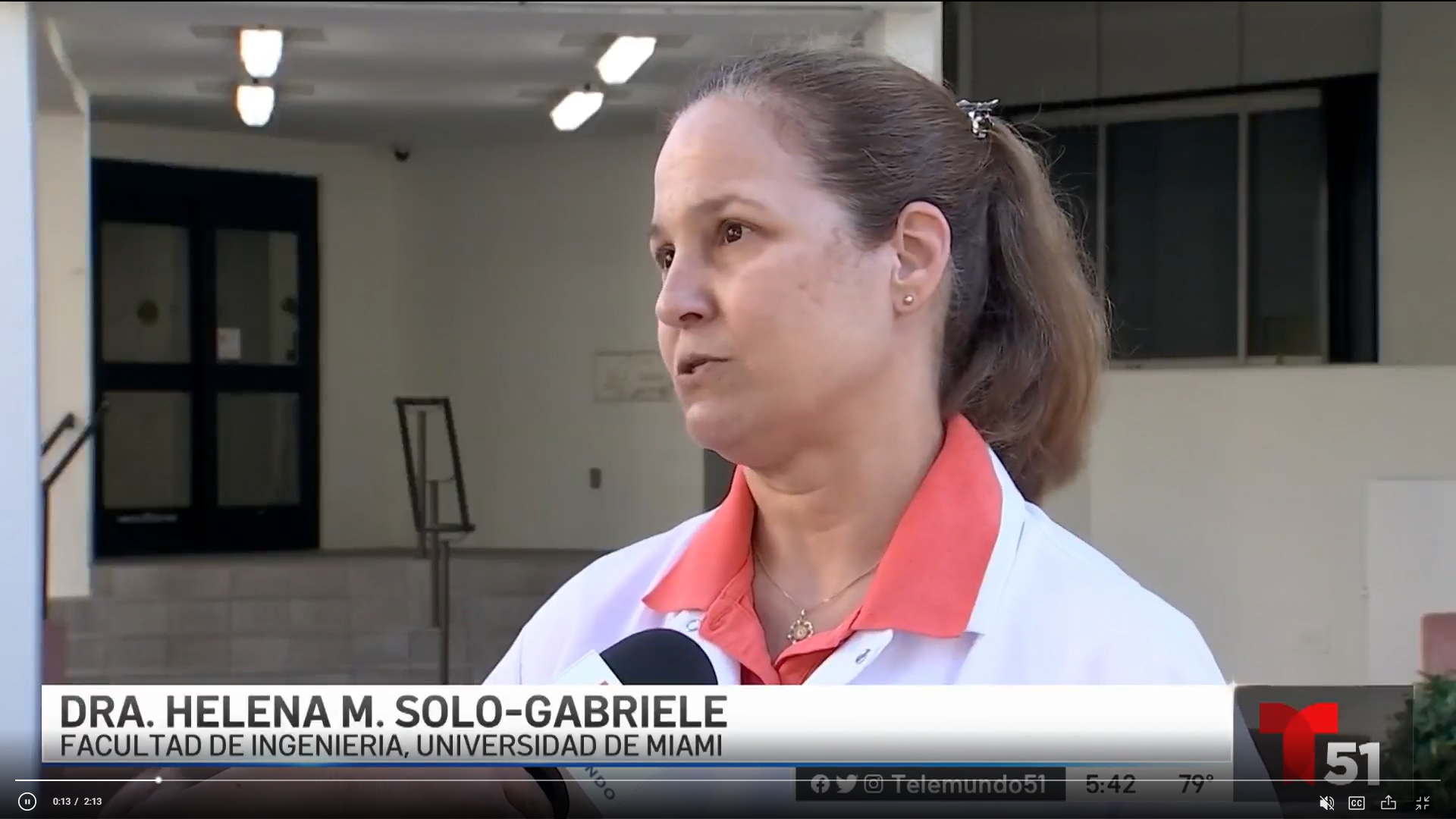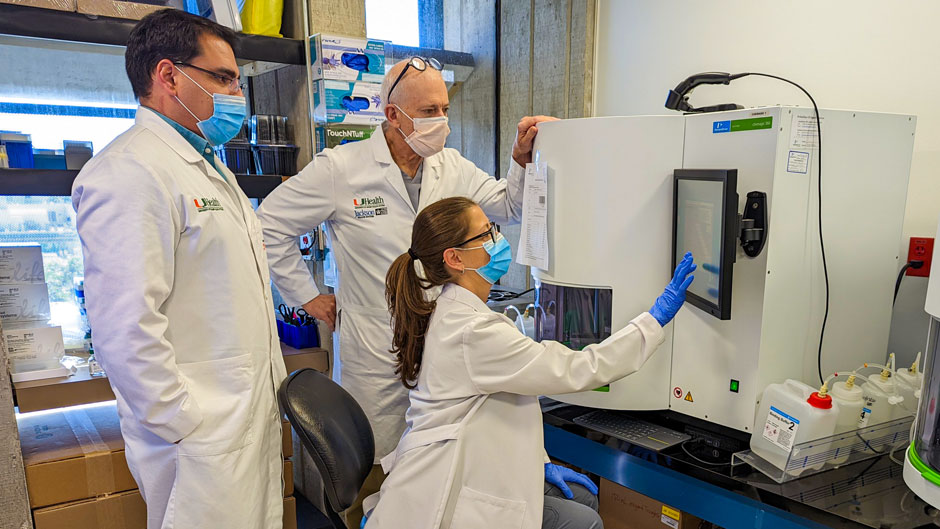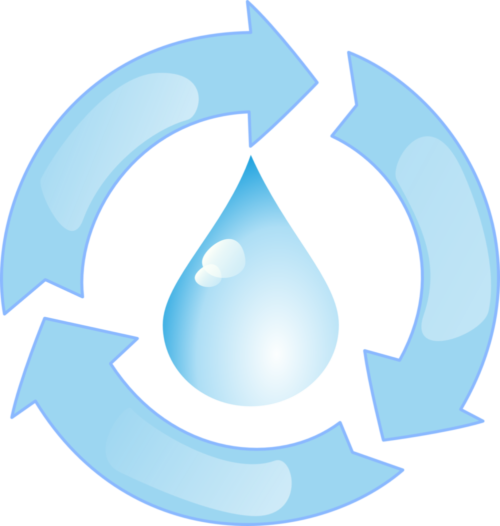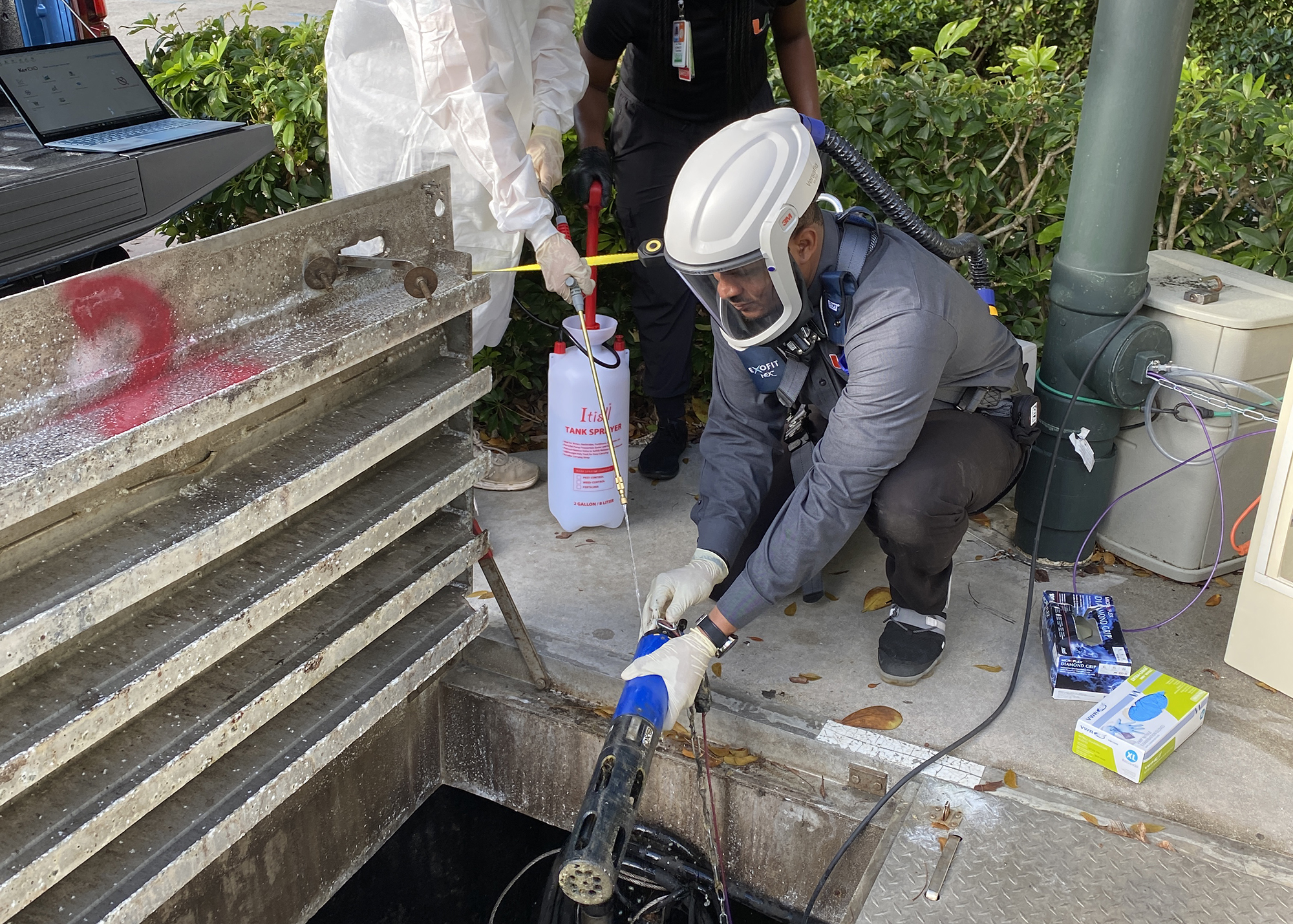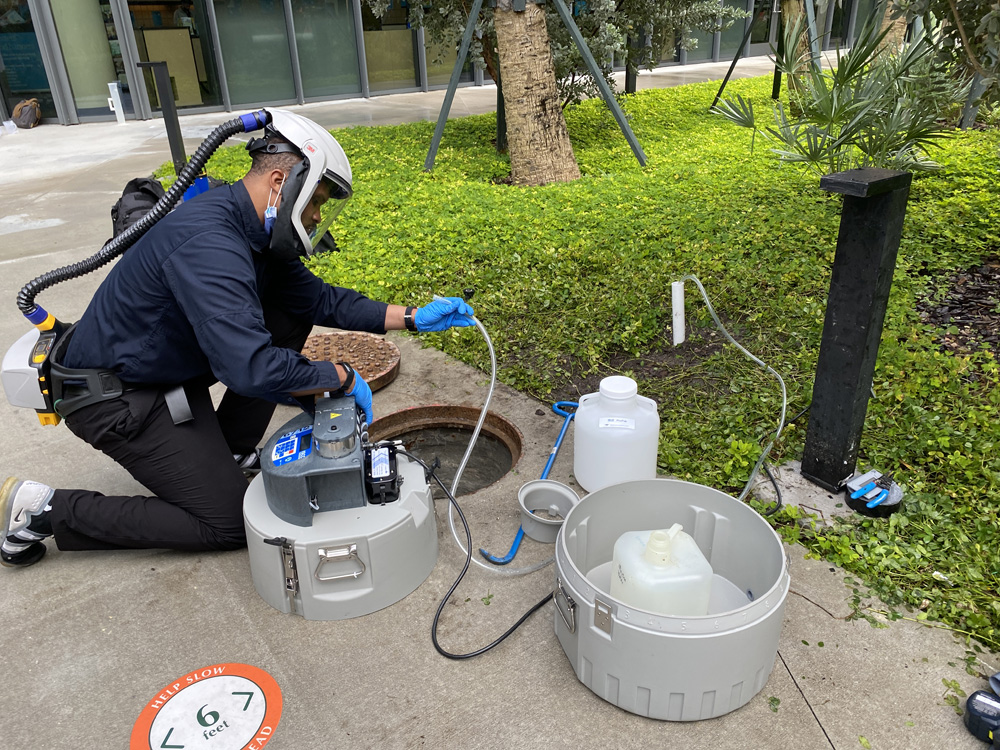A University of Miami-led team recently received a major federal grant to study how wastewater can be used to help predict coronavirus outbreaks.
 Although it is still challenging to prevent the transmission of COVID-19, researchers at the University of Miami are using all the strategies they can to fend off the spread. That includes using cutting-edge research to detect SARS-CoV-2—the virus that causes COVID-19—in wastewater. Detecting traces of the virus in sewage flowing from campus buildings may provide up to a week’s notice ahead of positive COVID-19 test results to warn students and faculty that they should get tested and self-isolate before the illness spreads.
Although it is still challenging to prevent the transmission of COVID-19, researchers at the University of Miami are using all the strategies they can to fend off the spread. That includes using cutting-edge research to detect SARS-CoV-2—the virus that causes COVID-19—in wastewater. Detecting traces of the virus in sewage flowing from campus buildings may provide up to a week’s notice ahead of positive COVID-19 test results to warn students and faculty that they should get tested and self-isolate before the illness spreads.
“Research has shown that people will start excreting the virus in their feces and urine before showing symptoms of COVID-19, so the idea is to use wastewater measurements as an early warning for a potential COVID-19 outbreak in the community,” said Helena Solo-Gabriele, professor of environmental engineering and associate dean of research for the College of Engineering.
Solo-Gabriele has been studying beach and water contamination in South Florida for more than a decade, so she was supported by University leadership to lead the group effort. And just a few weeks ago, this team of 40 faculty and staff members and students—including Solo-Gabriele’s co-investigators Stephan Schürer, a professor of molecular and cellular pharmacology at the Miller School of Medicine; and Christopher Mason, an associate professor of physiology and biophysics and of computational genomics in computational biomedicine, as well as co-director of the WorldQuant Initiative for Quantitative Prediction at Weill Cornell Medicine in New York City—were buoyed by the news that they had received a major grant from the National Institutes of Health (NIH), with funding starting this month. The two-year, $5 million dollar grant will help broaden the University’s own pilot program to detect the virus in wastewater.
 “With this new funding, the team will also join a consortium organized by the NIH to collect and standardize data from institutions across the United States that are testing wastewater for the virus,” Schürer said. Therefore, Schürer will work to create data criteria and software tools, so that the wastewater figures and associated information can be seamlessly stored, compiled, and analyzed. “This will help scientists correlate information from a range of sources more efficiently,” he added.
“With this new funding, the team will also join a consortium organized by the NIH to collect and standardize data from institutions across the United States that are testing wastewater for the virus,” Schürer said. Therefore, Schürer will work to create data criteria and software tools, so that the wastewater figures and associated information can be seamlessly stored, compiled, and analyzed. “This will help scientists correlate information from a range of sources more efficiently,” he added.
The researchers are grateful for the boost in funding because the team will now be able to expand and further evaluate innovative technologies for collecting, concentrating, and detecting the virus in wastewater. They will also investigate whether there is a relationship between the concentration of the virus in wastewater and the results of human testing to create models that can predict COVID-19 outbreaks.
Finally, led by Mason, they will utilize next-generation sequencing technology to characterize SARS-CoV-2 genetic variations, look for novel viruses, and link this data to national and global efforts to track emerging pathogens.
 Starting in August 2020, the University began regularly testing students who were taking in-person classes to get a comprehensive view of any COVID-19 transmissions and to help keep the virus’ spread as low as possible. At the same time, a program was also established for environmental surveillance of the virus using surface, air, and wastewater sampling, led by George S. Grills, associate director for shared resources at the Sylvester Comprehensive Cancer Center.
Starting in August 2020, the University began regularly testing students who were taking in-person classes to get a comprehensive view of any COVID-19 transmissions and to help keep the virus’ spread as low as possible. At the same time, a program was also established for environmental surveillance of the virus using surface, air, and wastewater sampling, led by George S. Grills, associate director for shared resources at the Sylvester Comprehensive Cancer Center.
As part of this effort, Solo-Gabriele’s team began regularly gathering and analyzing the wastewater samples from all three of the University’s campuses. Now that this team can ramp up their efforts, Erin Kobetz, who has been leading the University’s testing, tracking, and tracing efforts, said the data will likely become even more useful. According to Kobetz, the University hopes to randomly test students in the buildings where they are seeing an increased presence of the virus in the wastewater to help head off any potential COVID-19 outbreaks.
 “This is another tool in our armory that will provide critical information to manage the risk of exposure and outbreak,” said Kobetz, a trained epidemiologist who is also the University’s vice provost for research and scholarship. “It’s also incredible this team was able to leverage something that they were establishing to support the University’s management of COVID-19 for a broader scientific impact.”
“This is another tool in our armory that will provide critical information to manage the risk of exposure and outbreak,” said Kobetz, a trained epidemiologist who is also the University’s vice provost for research and scholarship. “It’s also incredible this team was able to leverage something that they were establishing to support the University’s management of COVID-19 for a broader scientific impact.”
Ultimately, Solo-Gabriele hopes to create a primer they can share with leaders across the nation about the best ways to identify the virus in wastewater and how it can be used to quickly warn individuals of potential infection. They also hope to offer strategies that communities can use to reduce imminent transmissions when they detect a spike in wastewater, she added.
The Research Team
The COVID-19 wastewater team at the University of Miami includes students and faculty and staff members from the College of Engineering, the Miller School of Medicine, Sylvester Comprehensive Cancer Center, Rosenstiel School for Marine and Atmospheric Science, University Facilities and Operations, Risk Management, Environmental Health and Safety, the Institute for Data Science and Computing, and the Miller School’s Safety and Compliance Office.
The research team also includes students and faculty and staff members from the Department of Physiology and Biophysics and the HRH Prince Alwaleed Bin Talal Bin Abdulaziz Alsaud Institute for Computational Biomedicine at Weill Cornell Medicine.
 To identify the level of SARS-CoV-2 in wastewater, Brian Reding, environmental health and safety officer, assisted by a rotation of students and research staff from the Sylvester Comprehensive Cancer Center’s Behavioral and Community-Based Research Shared Resource, will collect samples from 13 locations at the University each week. Solo-Gabriele’s team will then divide the sample and send a portion for sequencing and analysis to Mason—who has established an international consortium for these studies—at Weill Cornell Medicine in New York City. The other portion is analyzed at the University.
To identify the level of SARS-CoV-2 in wastewater, Brian Reding, environmental health and safety officer, assisted by a rotation of students and research staff from the Sylvester Comprehensive Cancer Center’s Behavioral and Community-Based Research Shared Resource, will collect samples from 13 locations at the University each week. Solo-Gabriele’s team will then divide the sample and send a portion for sequencing and analysis to Mason—who has established an international consortium for these studies—at Weill Cornell Medicine in New York City. The other portion is analyzed at the University.
 To prep the wastewater for analysis, samples are concentrated down to a few microliters. Then, Solo-Gabriele delivers the concentrate to Mark Sharkey, a research assistant professor of infectious diseases, who uses an innovative polymerase chain reaction (PCR) method he developed to determine whether the virus is present in a sample. “Sharkey’s method can produce results more rapidly and efficiently than other methods,” Solo-Gabriele noted. “Wastewater samples that are positive for the virus will be analyzed at the Sylvester Comprehensive Cancer Center Onco-Genomics Shared Resource to detect and identify the viral strain, which can help determine how fast the disease may spread,” Grills added.
To prep the wastewater for analysis, samples are concentrated down to a few microliters. Then, Solo-Gabriele delivers the concentrate to Mark Sharkey, a research assistant professor of infectious diseases, who uses an innovative polymerase chain reaction (PCR) method he developed to determine whether the virus is present in a sample. “Sharkey’s method can produce results more rapidly and efficiently than other methods,” Solo-Gabriele noted. “Wastewater samples that are positive for the virus will be analyzed at the Sylvester Comprehensive Cancer Center Onco-Genomics Shared Resource to detect and identify the viral strain, which can help determine how fast the disease may spread,” Grills added.
While the team got its bearings in the fall, it is now accelerating operation by collecting more samples, more frequently, and at a greater number of locations. “This will help get a better representation of where the virus may be located, and how it may be spreading,” Solo-Gabriele said.

 Simultaneously, another member of the team, Naresh Kumar, an associate professor of environmental health, is working with Alejandro Mantero, a biostatics research analyst at the University’s Clinical and Translational Science Institute, as well as Mason, to create an infectious disease model that could anticipate potential COVID-19 outbreaks, based on wastewater surveillance, human test results, and local hospitalization figures. The results from this project could help guide University and local leaders to make decisions in a timely way and improve disease transmission control efforts across the globe.
Simultaneously, another member of the team, Naresh Kumar, an associate professor of environmental health, is working with Alejandro Mantero, a biostatics research analyst at the University’s Clinical and Translational Science Institute, as well as Mason, to create an infectious disease model that could anticipate potential COVID-19 outbreaks, based on wastewater surveillance, human test results, and local hospitalization figures. The results from this project could help guide University and local leaders to make decisions in a timely way and improve disease transmission control efforts across the globe.
“We are learning that measuring wastewater is a powerful tool to understand what illnesses are in a community and how humans are contributing to these diseases, not only for COVID-19, but for public health in general. Because we can use it to monitor many different [pathogenic] organisms,” Solo-Gabriele said.
SOURCE: Story by Janette Neuwahl Tannen | February 9, 2021 in NEWS@TheU


